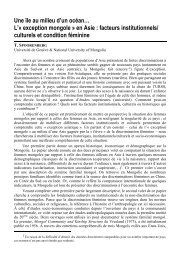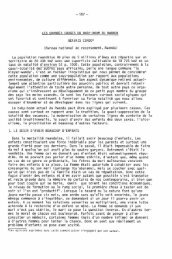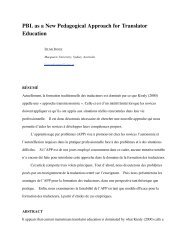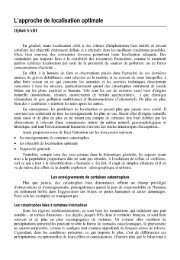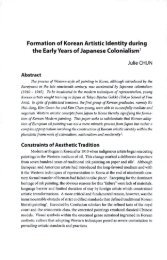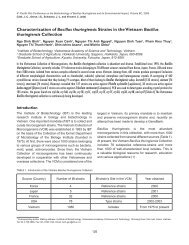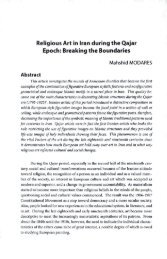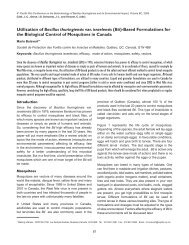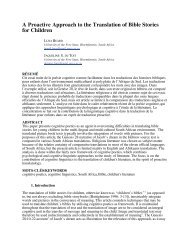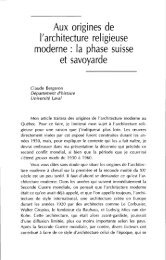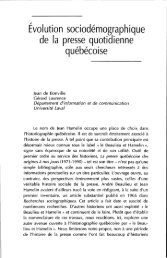Classically Inspired: The Poetics of Greek Mythology in French ...
Classically Inspired: The Poetics of Greek Mythology in French ...
Classically Inspired: The Poetics of Greek Mythology in French ...
Create successful ePaper yourself
Turn your PDF publications into a flip-book with our unique Google optimized e-Paper software.
<strong>Classically</strong> <strong>Inspired</strong>: <strong>The</strong> <strong>Poetics</strong><br />
<strong>of</strong> <strong>Greek</strong> <strong>Mythology</strong> <strong>in</strong> <strong>French</strong><br />
Neoclassical Pa<strong>in</strong>t<strong>in</strong>g, 1790-1825<br />
Katie HANSON<br />
Abstract<br />
Girodet's 1791 Endymion, the only iconic Neoclassiciz<strong>in</strong>g mythology <strong>in</strong> modernist<br />
art history, has been reassigned to Romanticism thanks to recognition <strong>of</strong> its theme<br />
<strong>of</strong> poetic <strong>in</strong>spiration. Indeed, <strong>in</strong> the years s<strong>in</strong>ce James Rub<strong>in</strong>'s 1978 iconographie <strong>in</strong>terpretation<br />
<strong>of</strong> the work, much has been made <strong>of</strong> its stylistic and thematic divergence from<br />
Davidian Neoclassicism. As such, thematic k<strong>in</strong>ship between his work and that <strong>of</strong> his<br />
contemporaries has been ignored. Through consideration <strong>of</strong> mythological compositions<br />
by Girodet's peer, Pierre Guér<strong>in</strong>, as well as a later work by Girodet himself, this paper<br />
demonstrates that the theme <strong>of</strong> creative <strong>in</strong>spiration was not Romantic idiosyncrasy<br />
<strong>in</strong> Girodet's early work. Rather, exploration <strong>of</strong> a variety <strong>of</strong> Neoclassical-style compositions<br />
<strong>of</strong> mythological subjects open to similar iconographie <strong>in</strong>terpretation suggests a<br />
thematic trend. To this end, I employ contemporaneous art criticism and philosophical<br />
treatises to situate these pa<strong>in</strong>t<strong>in</strong>gs with<strong>in</strong> the ^<strong>in</strong>terpretation <strong>of</strong> mythology itself.<br />
<strong>The</strong>mes <strong>of</strong> high emotion and imag<strong>in</strong>ation <strong>in</strong> the late XVIII e and early XIX 1 '<br />
century are typically considered emanations <strong>of</strong> Romanticism. <strong>The</strong> Romantic cult<br />
<strong>of</strong> the <strong>in</strong>dividual and celebration <strong>of</strong> genius are demonstrated <strong>in</strong> the proliferation <strong>of</strong><br />
personalized styles and subjects as well as the vogue for portraits <strong>of</strong> creative <strong>in</strong>dividuals.<br />
Thus, it has been easy to overlook that Neoclassical pa<strong>in</strong>ters addressed the<br />
more Romantic theme <strong>of</strong> creative <strong>in</strong>spiration us<strong>in</strong>g Greco-Roman mythology.<br />
In James Rub<strong>in</strong>'s 1978 article « Endymion's Dream as a Myth <strong>of</strong> Romantic Inspiration<br />
», he conv<strong>in</strong>c<strong>in</strong>gly attributed the theme <strong>of</strong> poetic <strong>in</strong>spiration to Girodet's<br />
1791 Endymion (Paris, Louvre). Girodet's youthful desire to dist<strong>in</strong>guish himself<br />
from his teacher, his self-identification as a poet, and his frustration <strong>in</strong> consistent<br />
atta<strong>in</strong>ment <strong>of</strong> academic honors have allowed him to be viewed as a « Romantic rebel<br />
» work<strong>in</strong>g outside the norms <strong>of</strong> Neoclassicism and the <strong>French</strong> Academy'. As such,<br />
similarities between Girodet's work and that <strong>of</strong> his peers have been read as homage
ACTES DU 8" COLLOQUE ETUDIANT DU DEPARTEMENT D'HISTOIRE<br />
to the frustrated genius and not as <strong>in</strong>dicative <strong>of</strong> a trend with<strong>in</strong> Neoclassicism 2 . Indeed,<br />
even his own 1819 Pygmalion (Paris, Louvre), thanks to its diffuse light and literal<br />
imag<strong>in</strong>g <strong>of</strong> artistic creation, has been <strong>in</strong>terpreted as a relapse <strong>in</strong>to an exhausted<br />
classicism and its thematic k<strong>in</strong>ship with his earlier Endymion dismissed 3 .<br />
Through new iconographie <strong>in</strong>terpretation <strong>of</strong> two compositions by Girodet's<br />
peer, Pierre Guér<strong>in</strong>, I aim to demonstrate that this theme <strong>of</strong> creative <strong>in</strong>spiration was<br />
not unique to Girodet. Rather than view<strong>in</strong>g Girodet's image <strong>of</strong> poetic <strong>in</strong>spiration<br />
as Romantic idiosyncrasy, exploration <strong>of</strong> a variety <strong>of</strong> mythological subjects open<br />
to similar <strong>in</strong>terpretation suggests a thematic trend. To this end, I will demonstrate<br />
that these Neoclassical-style mythological pa<strong>in</strong>t<strong>in</strong>gs fit with<strong>in</strong> a contemporaneous<br />
philosophical re<strong>in</strong>terpretation <strong>of</strong> mythology.<br />
<strong>The</strong> similarity <strong>of</strong> the male figures <strong>in</strong> Guér<strong>in</strong>'s Aurora and Cephalus (Paris,<br />
Louvre) and Iris and Morpheus (Sa<strong>in</strong>t Petersburg, Hermitage) to Girodet's Endymion<br />
have allowed modernist art history to overlook Guér<strong>in</strong>'s pa<strong>in</strong>t<strong>in</strong>gs as merely formal<br />
emulation <strong>of</strong> Girodet's work 11 . Yet, Girodet's figure was not an eccentric <strong>in</strong>vention;<br />
the artist acknowledged that he derived its pose, proportion, and details from famed<br />
classical sculptures, as well as the writ<strong>in</strong>gs <strong>of</strong> Johann Joachim W<strong>in</strong>ckelmann 5 . Furthermore,<br />
the upturned face and chest bathed <strong>in</strong> light are acknowledged to derive<br />
from allegorical representations <strong>of</strong> Inspiration, widely known from popular emblem<br />
books 6 . Standardized poses and expressions were fundamental to academic tra<strong>in</strong><strong>in</strong>g<br />
and emulation <strong>of</strong> antique art essential to Neoclassicism; thus, likeness should<br />
suggest thematic congruence, not empty imitation, <strong>in</strong> the work <strong>of</strong> the comparably<br />
tra<strong>in</strong>ed Guér<strong>in</strong> 7 . Similar emblematic poses and light also appear <strong>in</strong> Gross 1800 Sappho<br />
and <strong>in</strong> the 1788-93 frontispiece for Jean-Jacques Rousseau's Philosophie, further<br />
underscor<strong>in</strong>g their evident commonality and legibility <strong>in</strong> the visual arts before and<br />
after Girodet's pa<strong>in</strong>t<strong>in</strong>g.<br />
Guér<strong>in</strong>'s recl<strong>in</strong><strong>in</strong>g males also share with Girodet's Endymion the theme <strong>of</strong><br />
sleep. Rub<strong>in</strong> equated this theme <strong>in</strong> Endymion with Rousseau's theorization <strong>of</strong> restful<br />
repose as a state open to expanded consciousness and communion with the div<strong>in</strong>e*.<br />
Interest<strong>in</strong>gly, many Neoclassical-style mythological works pa<strong>in</strong>ted dur<strong>in</strong>g this period<br />
depict slumber<strong>in</strong>g characters suggest<strong>in</strong>g the broad contemporaneous importance<br />
<strong>of</strong> Rousseau, whose work is typically l<strong>in</strong>ked thematically with nascent Romanticism.<br />
This zoned out passivity certa<strong>in</strong>ly also dist<strong>in</strong>guishes them from the alert,<br />
active figures <strong>in</strong> portrayals <strong>of</strong> Roman history or Napoleonic conquest".<br />
Girodet depicted the shepherd boy beloved by the moon goddess and charmed<br />
<strong>in</strong>to perpetual slumber, while Guér<strong>in</strong> presented the goddess <strong>of</strong> the dawn with<br />
a huntsman she coveted and stole from his wife 10 . <strong>The</strong> Endymion narrative calls<br />
for sleep; however, the Aurora and Cephalus story relates that Aurora abducted a<br />
resistant hunter, not a languorous sleeper. <strong>The</strong>re is no classical precedent for the<br />
214
Œuvres d'art : lieux de discours et de critiques<br />
version <strong>of</strong> the story Guér<strong>in</strong> pictured here"; however, it effectively downplays the<br />
theme <strong>of</strong> abduction and highlights the erotic, amorous potential <strong>of</strong> this div<strong>in</strong>e love<br />
story. Equation <strong>of</strong> div<strong>in</strong>e love with poetic <strong>in</strong>spiration dates back to Plato and had<br />
enjoyed a resurgence <strong>in</strong> the late XVIII e century <strong>in</strong> France thanks to translations <strong>of</strong><br />
ancient texts and renewed <strong>in</strong>quiry <strong>in</strong>to artistic process. While most Enlightenment<br />
philosophers expla<strong>in</strong>ed that artists were simply especially keen observers <strong>of</strong> the natural<br />
world, Denis Diderot, at least for a time, championed enthusiasm, def<strong>in</strong>ed by<br />
heightened emotion and div<strong>in</strong>e <strong>in</strong>tervention, as the root <strong>of</strong> creativity 12 .<br />
Indeed, the physical presence <strong>of</strong> the lusty goddess is a dist<strong>in</strong>ct difference<br />
between Girodet's composition and Guér<strong>in</strong>'s. This type <strong>of</strong> adulterous story and erotic<br />
imagery had been decried by critic La Font de Sa<strong>in</strong>t Yenne <strong>in</strong> his review <strong>of</strong> the<br />
1753 Salon; however, over the course <strong>of</strong> the second half <strong>of</strong> the XVIII e century the<br />
status and analysis <strong>of</strong> <strong>Greek</strong> mythology changed markedly". <strong>The</strong> immorality was no<br />
longer taken literally; <strong>in</strong>stead, the bawdy stories were <strong>in</strong>terpreted as poetic celebrations<br />
<strong>of</strong> nature's creative abilities as discussed <strong>in</strong> Charles Dupuis's <strong>in</strong>fluential 1795<br />
Orig<strong>in</strong> <strong>of</strong> All Cults". A proliferation <strong>of</strong> amorous mythological subjects <strong>in</strong> large-scale<br />
<strong>French</strong> pa<strong>in</strong>t<strong>in</strong>g co<strong>in</strong>cided with this new appraisal <strong>of</strong> myth; prom<strong>in</strong>ent w<strong>in</strong>gs and<br />
placement <strong>of</strong> figures and structures al<strong>of</strong>t on clouds heighten the supernatural aspect<br />
<strong>of</strong> these pa<strong>in</strong>t<strong>in</strong>gs leav<strong>in</strong>g no doubt that these titillat<strong>in</strong>g scenes portray the love <strong>of</strong><br />
a god.<br />
Furthermore, <strong>in</strong>stead <strong>of</strong> view<strong>in</strong>g mythology as the perversion <strong>of</strong> ancient historical<br />
events, as had been common at mid-century, late XVIII e century th<strong>in</strong>kers<br />
praised myth as evidence <strong>of</strong> the longevity <strong>of</strong> the human creative impulse 15 . Moreover,<br />
the Poetic History, released <strong>in</strong> five editions <strong>in</strong> Paris dur<strong>in</strong>g the later XVIII e century,<br />
asserted that « the language <strong>of</strong> fable is that <strong>of</strong> poetry [...] mythology is noth<strong>in</strong>g more<br />
than a knowledge <strong>of</strong> poetic history". » <strong>The</strong> XVIIP-century Encyclopédie clarifies<br />
this dist<strong>in</strong>ction: « <strong>The</strong> orator and the historian have noth<strong>in</strong>g to create, they do not<br />
need genius except to f<strong>in</strong>d the real aspects that are <strong>in</strong> their objective [... ] they barely<br />
dare to transpose, whereas the poet creates models for himself without burden<strong>in</strong>g<br />
himself with reality. <strong>The</strong> orator must speak the truth [...] with persuasive force and<br />
simplicity. <strong>The</strong> poet must speak <strong>of</strong> the plausible [... ] with grace and energy that can<br />
charm and surprise 17 . » Thus, as poetry, mythology was associated with creativity<br />
and genius; <strong>in</strong> embrac<strong>in</strong>g mythology artists could abandon reality and « reportage<br />
» as it was understood to relate to explanation and portrayal <strong>of</strong> historical events. I<br />
contend that mythology released Neoclassical pa<strong>in</strong>ters from literal, historical reality<br />
and allowed them to explore unreality, and thus <strong>in</strong>ventiveness and creativity, so <strong>in</strong>timately<br />
l<strong>in</strong>ked with the supernatural forces celebrated <strong>in</strong> ancient religion.<br />
Guér<strong>in</strong> deviated from the traditional narrative <strong>of</strong> the Aurora and Cephalus<br />
story, but <strong>in</strong> so do<strong>in</strong>g created someth<strong>in</strong>g poetic. Indeed, references to poets and<br />
poetry resound <strong>in</strong> critical responses to its 1810 Salon appearance. M. Boutard wrote:<br />
215
ACTES DU 8" COLLOQUE ÉTUDIANT DU DÉPARTEMENT D'HISTOIRE<br />
« Aurora smitten with Cephalus was a subject suitable to the poetic brush <strong>of</strong> M.<br />
Guér<strong>in</strong> 18 . «While François Guizot asserted: « It is this good sense, vivified by a poetic<br />
sentiment and ennobled by a pure and elegant taste, that I f<strong>in</strong>d and that charms<br />
me <strong>in</strong> compositions by M. Guér<strong>in</strong> 19 . » Guizot was so certa<strong>in</strong> that he sensed someth<strong>in</strong>g<br />
poetic <strong>in</strong> Guér<strong>in</strong>'s pa<strong>in</strong>t<strong>in</strong>g, that he quoted Petrarch's Laura and asserted that<br />
whether or not Guér<strong>in</strong> read poetry, his compositions made the viewer th<strong>in</strong>k <strong>of</strong> it.<br />
For Guér<strong>in</strong>'s contemporaries, the pa<strong>in</strong>t<strong>in</strong>g appeared poetic <strong>in</strong> its f<strong>in</strong>ish, sentiment,<br />
and similarity to familiar verses. Additionally, Aurora herself had been associated<br />
with poetry and poetic <strong>in</strong>spiration s<strong>in</strong>ce at least the time <strong>of</strong> Homer and cont<strong>in</strong>ued to<br />
be so l<strong>in</strong>ked <strong>in</strong> early XIX e century mythographies. One by François Noël notes that<br />
Homer « depicts her with a great veil on her head that recoils to the back to <strong>in</strong>dicate<br />
that the obscurity <strong>of</strong> night is beg<strong>in</strong>n<strong>in</strong>g to dissipate while she opens the doors <strong>of</strong> the<br />
day with her rose-colored f<strong>in</strong>gers ». Noël describes this as a well-known allegory<br />
and calls Aurora a friend <strong>of</strong> poets 2 ".<br />
Guér<strong>in</strong>'s adaptation <strong>of</strong> narrative and imagery fit with a contemporaneous renewal<br />
<strong>of</strong> allegorization. In his 1766 study <strong>of</strong> allegory, Johann Joachim W<strong>in</strong>ckelmann<br />
expla<strong>in</strong>ed antique emblems and promoted usage <strong>of</strong> deities for new allegories 21 ,<br />
W<strong>in</strong>ckelmann's well-known publication and Hubert François Gravelot and Charles<br />
Nicolas Coch<strong>in</strong>'s 1791 Iconologie par figures encouraged artists not just to repeat<br />
cliché historical examples but to use them as start<strong>in</strong>g po<strong>in</strong>ts to create modern allegories.<br />
Appreciation <strong>of</strong> myth as poetry encouraged <strong>in</strong>terpretive adaptation rather<br />
than strict illustration and artistic handbooks equated poetic and pa<strong>in</strong>terly language<br />
as both call<strong>in</strong>g on the imag<strong>in</strong>ation through allusion 22 .<br />
Selection <strong>of</strong> the Aurora and Cephalus narrative allowed for associations <strong>of</strong><br />
creative <strong>in</strong>spiration through visualization <strong>of</strong> div<strong>in</strong>e love and presentation <strong>of</strong> a goddess<br />
closely associated with <strong>in</strong>spiration and poetry. <strong>The</strong> female figure, while obviously<br />
Aurora, as named <strong>in</strong> the pa<strong>in</strong>t<strong>in</strong>g's title and imaged push<strong>in</strong>g back the veil<br />
<strong>of</strong> night while deposit<strong>in</strong>g flowers, conspicuously lacks the chariot and orange robes<br />
described <strong>in</strong> many emblem books and mythographies 2 '. Instead, hover<strong>in</strong>g and just<br />
barely clad <strong>in</strong> white gauze, she seems to take on the characteristics emblematic for<br />
Idea. Cesare Ripas emblem book, cited as a major source by both W<strong>in</strong>ckelmann and<br />
by Gravelot and Coch<strong>in</strong>, <strong>in</strong>cludes the follow<strong>in</strong>g description <strong>of</strong> Idea: « A beautiful<br />
Lady, rapt <strong>in</strong>to the Air; cover<strong>in</strong>g her Nakedness only with a f<strong>in</strong>e white Veil; a Flame<br />
on her Head; her Forehead surrounded with a circle <strong>of</strong> Gold [... ] po<strong>in</strong>ts at a very f<strong>in</strong>e<br />
Country ly<strong>in</strong>g underneath. In the Air, because immaterial, and immutable; naked,<br />
exempt from corporeal Passion: the white Veil, the Purity <strong>of</strong> Ideas, differ<strong>in</strong>g from<br />
corporeal Th<strong>in</strong>gs 24 . » While Ripa calls for a golden headband, Guér<strong>in</strong> has encircled<br />
the goddess's torso with a golden belt; otherwise, Aurora matches the emblematic<br />
description closely, heighten<strong>in</strong>g my contention that the pa<strong>in</strong>t<strong>in</strong>g portrays mental<br />
process <strong>in</strong> mythological guise rather than illustrat<strong>in</strong>g myth.<br />
216
Œuvres d'art : lieux de discours et de critiques<br />
<strong>The</strong> Aurora and Cephalus was so widely esteemed that Guér<strong>in</strong> immediately<br />
received a commission from Pr<strong>in</strong>ce Nikolay Yusupov <strong>of</strong> Russia for a second version<br />
(Moscow, Pushk<strong>in</strong>) 25 . Yusupov had held prom<strong>in</strong>ent political and cultural positions,<br />
<strong>in</strong>clud<strong>in</strong>g manag<strong>in</strong>g the Hermitage and the Russian imperial theaters 26 . Upon retirement<br />
<strong>in</strong> 1802, he ma<strong>in</strong>ta<strong>in</strong>ed his engagement with the visual and perform<strong>in</strong>g arts<br />
<strong>in</strong> his new estate, which housed his own theater, as well as four hundred works <strong>of</strong><br />
art and twenty thousand books 27 . Patron and artist were both avid bibliophiles, so<br />
discrepancy between text and image would not have gone unnoticed and, hence,<br />
must have been <strong>in</strong>tentional and appreciated 28 . Indeed, <strong>in</strong> Yusupov's Aurora and Cephalus,<br />
Guér<strong>in</strong> ma<strong>in</strong>ta<strong>in</strong>ed the compositional elements and the narrative divergence<br />
demonstrated to be emblematic <strong>of</strong> poetic <strong>in</strong>spiration.<br />
This second poetic Aurora and Cephalus was to be paired with a complementary<br />
pendant, the Iris and Morpheus, for which Guér<strong>in</strong> also deviated from classical<br />
precedent. Ovid is the only classical author to relate a story <strong>in</strong>clud<strong>in</strong>g both Iris<br />
and Morpheus; however, <strong>in</strong> the Metamorphoses, Juno's faithful messenger Iris visits<br />
Hypnos, the god <strong>of</strong> sleep, to implore him to send Alcyone a dream 2 *. Hypnos then<br />
selects his son Morpheus to impersonate Alcyone's husband <strong>in</strong> her dream; Iris and<br />
Morpheus have no immediate contact <strong>in</strong> Ovid's tale"'. Guér<strong>in</strong>'s pa<strong>in</strong>t<strong>in</strong>g presents a<br />
clever elision where<strong>in</strong> Iris appears directly to Morpheus without the <strong>in</strong>tervention <strong>of</strong><br />
Hypnos and any source for this deviation rema<strong>in</strong>s unclear.<br />
While the typically aged Hypnos could have been rendered <strong>in</strong> youthful form<br />
to pair with Cephalus, Guér<strong>in</strong>'s choice <strong>of</strong> Morpheus <strong>in</strong>stead suggests the importance<br />
<strong>of</strong> that particular figure". Accord<strong>in</strong>g to contemporaneous mythographies and emblem<br />
books, as well as the Encyclopédie and Ovid, Morpheus, <strong>of</strong> all his brothers, was<br />
« the most able to take on the gait, appearance, air, and voice <strong>of</strong> those he wanted<br />
to represent 12 . » His very name further highlights this ability to morph <strong>in</strong>to those<br />
he wished to <strong>in</strong>s<strong>in</strong>uate <strong>in</strong>to one's dreams. <strong>The</strong> details <strong>of</strong> Yusupov's commission for<br />
this pa<strong>in</strong>t<strong>in</strong>g are no longer extant, mak<strong>in</strong>g it impossible to know if the artist or the<br />
patron selected the specific subject. It is known, however, that Yusupov's <strong>in</strong>timate<br />
<strong>in</strong>volvement with the visual arts and the theater colored his first <strong>in</strong>teraction with<br />
Guér<strong>in</strong> <strong>in</strong> 1802, when he attempted to purchase one <strong>of</strong> Guér<strong>in</strong>'s many canvases display<strong>in</strong>g<br />
subjects taken from dramas written by Jean Rac<strong>in</strong>e". Indeed, Guér<strong>in</strong> shared<br />
with his patron an avowed love <strong>of</strong> theater' 4 . Thus, it seems apposite that for Yusupov<br />
he would produce a picture <strong>of</strong> a mythological character notable for his act<strong>in</strong>g<br />
skills. <strong>The</strong> composition itself also displays a theatrical quality <strong>in</strong> the choreographic<br />
way Iris's arm seems to cause Morpheus's to rise 35 . Certa<strong>in</strong>ly, the performers and<br />
statesmen Yusupov hosted would have been amused by this and by the <strong>in</strong>genious<br />
adjustment <strong>of</strong> the Ovidian tale. Aurora and Cephalus preserves its connotation <strong>of</strong><br />
poetic <strong>in</strong>spiration; by pair<strong>in</strong>g it for Yusupov with Iris and Morpheus, which ma<strong>in</strong>ta<strong>in</strong>s<br />
the same basic composition, the pendants suggest the <strong>in</strong>terpretive creativity <strong>of</strong><br />
217
ACTES DU 8' COLLOQUE ÉTUDIANT DU DEPARTEMENT D'HISTOIRE<br />
actors and the theater as well. Neither Ripa, Gravelot, nor W<strong>in</strong>ckelmann provided<br />
an emblem for theatrical <strong>in</strong>spiration; here, Guér<strong>in</strong> devised a specialized, modern<br />
allegorical image.<br />
While the selection <strong>of</strong> Morpheus rather than Hypnos allows for connotations<br />
<strong>of</strong> act<strong>in</strong>g, the details <strong>of</strong> the picture suggest that the two characters may have been<br />
conflated. <strong>The</strong> Encyclopédie relates the Ovidian tale <strong>of</strong> Iris wak<strong>in</strong>g Hypnos, god <strong>of</strong><br />
sleep, and states that he holds the head <strong>of</strong> a lion while rest<strong>in</strong>g <strong>in</strong> an ebony bed surrounded<br />
by a black curta<strong>in</strong>, a description strik<strong>in</strong>gly similar to that <strong>of</strong> the environs<br />
<strong>of</strong> Guér<strong>in</strong>'s Morpheus' 6 . Perhaps the comb<strong>in</strong>ation <strong>of</strong> elements <strong>of</strong> Sleep with those<br />
<strong>of</strong> Morpheus, one <strong>of</strong> the Dreams, results from the negative connotations many philosophers<br />
gave to dreams as manifestations <strong>of</strong> the irrational m<strong>in</strong>d. Sleep itself was<br />
understood as the body's recuperative mechanism and Guér<strong>in</strong> has given both Cephalus<br />
and Morpheus the bent arm overhead typical <strong>of</strong> allegorical figures <strong>of</strong> Sleep".<br />
Rousseau's notions <strong>of</strong> the potential <strong>of</strong> such restful repose to expand consciousness<br />
align nicely with the subjects presented by Guér<strong>in</strong>' 8 . Furthermore, Yusupov esteemed<br />
Rousseau, and his library prom<strong>in</strong>ently featured a bust <strong>of</strong> the philosopher 3 *.<br />
Yusupov, then, likely subscribed to the notion <strong>of</strong> sleep as a period <strong>of</strong> Rousseauian<br />
reverie allow<strong>in</strong>g for expanded consciousness and div<strong>in</strong>e communion.<br />
My reconsideration <strong>of</strong> Guér<strong>in</strong>'s mythological works expands our understand<strong>in</strong>g<br />
<strong>of</strong> the specific works; however, it also elucidates the cultural context with<strong>in</strong><br />
which myth resurged <strong>in</strong> large-scale <strong>French</strong> pa<strong>in</strong>t<strong>in</strong>g, thereby suggest<strong>in</strong>g the merit <strong>of</strong><br />
analyz<strong>in</strong>g these works as part <strong>of</strong> a unified subset <strong>of</strong> Neoclassicism. Indeed, Guér<strong>in</strong><br />
and Girodet both selected to close their pa<strong>in</strong>terly careers us<strong>in</strong>g amorous mythological<br />
subjects. Girodet's 1819 Pygmalion has been <strong>in</strong>terpreted recently as a last-gasp<br />
effort to regenerate classicism and to secure Girodet's <strong>in</strong>stitutional reputation' 1 ". Alternatively,<br />
Guér<strong>in</strong> had been one <strong>of</strong> the most sought after pa<strong>in</strong>ters and teachers <strong>in</strong><br />
Paris dur<strong>in</strong>g the first two decades <strong>of</strong> the XIX e century and he went on the prestigious<br />
role <strong>of</strong> the director <strong>of</strong> the <strong>French</strong> Academy <strong>in</strong> Rome, yet Guér<strong>in</strong>'s request <strong>in</strong> his will<br />
that each <strong>of</strong> his pupils receive a pr<strong>in</strong>t after his Aurora and Cephalus has heret<strong>of</strong>ore<br />
gone without notice or comment 41 . Girodet's Pygmalion and the c.1820 engrav<strong>in</strong>g by<br />
Forster after Guér<strong>in</strong>'s Aurora and Cephalus share a focus on amorous mythological<br />
themes, a stilted quality <strong>in</strong> their depicted gestures, and a cloak<strong>in</strong>g <strong>of</strong> the male genitalia;<br />
as such, I contend that they all downplay the literal sexual potential <strong>of</strong> amorous<br />
<strong>in</strong>teraction, while highlight<strong>in</strong>g the celestial, and thus, the metaphoric celebration<br />
<strong>of</strong> creativity. <strong>The</strong>ir antique subjects demonstrate the longevity <strong>of</strong> the creative spirit<br />
and its supernatural aspect - artistic genius was not slavishly tra<strong>in</strong>ed, but bestowed<br />
lov<strong>in</strong>gly from above. That two such dist<strong>in</strong>ct contemporaries each marked his career's<br />
end with the same theme urges situation <strong>of</strong> these works culturally, and <strong>in</strong>deed,<br />
other Neoclassical pa<strong>in</strong>ters, such as Jacques-Louis David and Anto<strong>in</strong>e-Jean Gros,<br />
also closed their careers <strong>in</strong> this way, further underscor<strong>in</strong>g the merit <strong>of</strong> reexam<strong>in</strong><strong>in</strong>g<br />
218
Œuvres d'art : lieux de discours et de critiques<br />
these pa<strong>in</strong>t<strong>in</strong>gs as a unified group. In present<strong>in</strong>g ideal bodies and classical narratives<br />
characteristic <strong>of</strong> Neoclassicism with a theme more Romantic <strong>in</strong> tenor, these pa<strong>in</strong>t<strong>in</strong>gs<br />
deepen revisionist explorations <strong>of</strong> the cont<strong>in</strong>uities <strong>in</strong> <strong>French</strong> narrative pa<strong>in</strong>t<strong>in</strong>g<br />
from the XVIII e <strong>in</strong>to the XIX e century.<br />
Notes<br />
1 For an excellent summary <strong>of</strong> scholarship on Girodet see: Sylva<strong>in</strong> Bellenger (dir.), G/rodet, 1767-1824,<br />
Paris, Editions Gallimard, 2006, on Endymion, see especially p. 206-217. When the exhibition appeared<br />
at the Metropolitan Museum <strong>of</strong> Art <strong>in</strong> New York, it was entitled * Girodet: Romantic Rebel ».<br />
2 James Rub<strong>in</strong>, « Gros and Girodet », Burl<strong>in</strong>gton Magaz<strong>in</strong>e, vol. 121, no 920 (1979), p. 708, 713-721;<br />
Sylva<strong>in</strong> Bellenger, « Aurora and Cephalus: A Story <strong>of</strong> Acquisition », Cleveland Studies <strong>in</strong> the History <strong>of</strong><br />
Art, vol. 8 (2003), p. 188-99; Monique Moul<strong>in</strong>, « Daphnis et Chloé dans l'oeuvre de François Gérard<br />
(1770-1837) », La Revue du Louvre et des musées de France, vol. 33, no 2 ( 1983), p. 100-109.<br />
3 Stephanie Nev<strong>in</strong>son Brown, Girodet: A Contradictory Career, Ph.D. (Art History), London, Courtauld<br />
Institute <strong>of</strong> Art, University <strong>of</strong> London, 1980; James Rub<strong>in</strong>, « Pygmalion and Galatea: Girodet<br />
and Rousseau », Burl<strong>in</strong>gton Magaz<strong>in</strong>e, vol. 127, no 989 (August 1985), p. 517-520; Alexandra<br />
K. Wettlaufer, Pen vs. Pa<strong>in</strong>tbrush: Girodet, Balzac, and the Myth <strong>of</strong> Pygmalion <strong>in</strong> Postrevolutionary<br />
France, New York, Palgrave, 2001; Chiara Savettieri, « "II avait retrouvé le secret de Pygmalion": Girodet,<br />
Canova e l'illusione della vita », Studiolo vol. 2 (2003), p. 14-42. Only Bellenger (dir.), op. cit.,<br />
p. 462-468 acknowledges thematic congruence, but <strong>in</strong> so do<strong>in</strong>g stresses the s<strong>in</strong>gularity <strong>of</strong> Girodet's<br />
achievements by <strong>in</strong>terpret<strong>in</strong>g these works exclusively <strong>in</strong> terms <strong>of</strong> his personality and <strong>in</strong>dividual artistic<br />
goals.<br />
4 Thomas Crow, Emulation: Mak<strong>in</strong>g Artists for Revolutionary France, New Haven and London, Yale<br />
University Press, 1995, p. 262; Stephen Eisenman, N<strong>in</strong>eteenth Century Art: A Critical History, New<br />
York, Thames and Hudson, 1994 and 2002, p. 61; Sylva<strong>in</strong> Bellenger, « Aurora and Cephalus: A Story<br />
<strong>of</strong> Acquisition ». Cleveland Studies <strong>in</strong> the History <strong>of</strong> Art, vol. 8 (2003), p. 188-199.1 am <strong>in</strong>debted to<br />
the essential archival work, which provides basis for further study <strong>of</strong> Guér<strong>in</strong>'s mythological pa<strong>in</strong>t<strong>in</strong>gs<br />
for <strong>in</strong> Josette Bott<strong>in</strong>eau, « Pierre Guér<strong>in</strong> et le merveilleux mythologique: LAurore et Céphale, Iris et<br />
Morphée ». Gazette des beaux-arts, vol. 134 (1999), p. 271-288.<br />
5 Bellenger, (dir.), op. cit., p. 206-217.<br />
6 Ibid.; Jean-Baptiste Boudard, Iconologie tirée de divers auteurs: ouvrage utile aux gens de lettres, poètes,<br />
aux artistes, et généralement à tous les amateurs des beaux arts, 3 vols., Parme, Chez Boudard, 1759.<br />
7 J. J. W<strong>in</strong>ckelmann, Recueil de différentes pièces sur les arts, Paris, Barrois, 1786; Pierre-Marie Gault de<br />
Sa<strong>in</strong>t-Germa<strong>in</strong>, Des Passions et leur expression générale et particulière sous le rapport des beaux-arts,<br />
Paris, Delance et Lesueur, 1804; Francis Haskell and Nicholas Penny, Taste and the Antique: <strong>The</strong> Lure<br />
<strong>of</strong> Classical Sculpture, 1500 - 1900, New Haven, Yale University Press, 1981, p. 99-107.<br />
8 Rub<strong>in</strong>, loc. cit., p. 74; Jean Starob<strong>in</strong>ski, Jean-Jacques Rousseau: Transparency and Obstruction, trans.<br />
Arthur Goldhammer, Chicago, University <strong>of</strong> Chicago Press, 1988, p. 113 and 168.<br />
9 Abigail Solomon-Godeau, Male Trouble: A Crisis <strong>in</strong> Representation, New York, Thames and Hudson,<br />
1997; Alex Potts, Flesh and the Ideal: W<strong>in</strong>ckelmann and the Orig<strong>in</strong>s <strong>of</strong> Art History, New Haven, Yale<br />
University Press, 1994 and 2000, especially chap. 7.<br />
10 Ovid, Nouvelle traduction des Métamorphoses d'Ovide par M. Fontanelle, Paris, Panckoucke, 1767,<br />
vol. 1, book 7; Ovid, Les Métamorphoses d'Ovide, traduites en vers, avec des remarques et des notes, par<br />
M. Desa<strong>in</strong>tange, Paris, Desray, 1808, vol. 2: book 7.<br />
219
ACTES DU 8* COLLOQUE ÉTUDIANT DU DÉPARTEMENT D'HISTOIRE<br />
Apollodorus, <strong>The</strong> Library <strong>of</strong> <strong>Greek</strong> <strong>Mythology</strong>, trans. Rob<strong>in</strong> Hard, Oxford and New York, Oxford University<br />
Press, 1997, p. 44, 131, 189, 239 reveals that there were two Cephaluses: one married to Procris,<br />
the other ravished by Aurora; Anto<strong>in</strong>e Banier, <strong>The</strong> <strong>Mythology</strong> and Fables <strong>of</strong> the Ancients, Expla<strong>in</strong>'d<br />
from History. Translated from the Orig<strong>in</strong>al <strong>French</strong>, London, Millar, 1739-1740, p. 379 sheds light on<br />
the conflation <strong>of</strong> these two stories; Francois Noël, Dictionnaire de la fable; ou, Mythologie grecque,<br />
lat<strong>in</strong>e, égyptienne, celtique, persane, syriaque, <strong>in</strong>dienne, ch<strong>in</strong>oise, mahométane, rabb<strong>in</strong>ique, slavonne,<br />
Scand<strong>in</strong>ave, africa<strong>in</strong>e, américa<strong>in</strong>e, iconologique, etc., Paris, Le Normant, 1803, vol. I, p. 166 comb<strong>in</strong>es<br />
the two Cephalus stories, stat<strong>in</strong>g that after the death <strong>of</strong> Procris, Aurora took Cephalus away to Syria<br />
<strong>in</strong> an effort to ease his pa<strong>in</strong>, echo<strong>in</strong>g the assessment by Le chevalier du Jaucourt, « Aurore », <strong>in</strong> Denis<br />
Diderot and Jean Le Rond d'Alembert (dir.), Encyclopédie, ou, Dictionnaire raisonné des sciences, des<br />
arts et des métiers, par une société de gens de letters, Paris, Le Breton, 1751-1765, vol. l,p. 889. None <strong>of</strong><br />
these specifies that Cephalus was sleep<strong>in</strong>g.<br />
K<strong>in</strong>eret S. Jaffe, * <strong>The</strong> Concept <strong>of</strong> Genius: Its Chang<strong>in</strong>g Role <strong>in</strong> Eighteenth-Century <strong>French</strong> Aesthetics<br />
», Journal <strong>of</strong> the History <strong>of</strong> Ideas, vol. 41, no 4 (Oct.-Dec. 1980), p. 579-99. See also Michel François<br />
Dandré-Bardon, Traité de pe<strong>in</strong>ture, Paris, 1765; repr<strong>in</strong>ted: Genève, M<strong>in</strong>k<strong>of</strong>f, 1972, vol. I, p. 145-146;<br />
Rub<strong>in</strong>, loc. cit., p. 75-76 also mentions Diderot, Jean-François Marmontel's supplement to Voltaire,<br />
Lebrun-P<strong>in</strong>dar's odes, republications <strong>of</strong> Plato's Ion on the subject <strong>of</strong> enthusiasm (<strong>in</strong> its antique def<strong>in</strong>ition<br />
<strong>of</strong> possession by a god).<br />
La Font de Sa<strong>in</strong>t-Yenne. « Sentiments sur quelques ouvrages de pe<strong>in</strong>ture, sculpture et gravure »,<br />
Paris, 1754 repr<strong>in</strong>ted <strong>in</strong> Etienne Jollet (dir.). Oeuvres critiques, Paris, Ecole nationale supérieure des<br />
beaux-arts, 2001; Frank Manuel, <strong>The</strong> Eighteenth Century Confronts the Gods, Cambridge, Harvard<br />
University Press, 1959; Burton Feldman and Robert D. Richardson, <strong>The</strong> Rise <strong>of</strong> Modern <strong>Mythology</strong>,<br />
1680-1860, Bloom<strong>in</strong>gton and London, Indiana University Press, 1972; C. Jamme, « Portray<strong>in</strong>g Myth<br />
More Conv<strong>in</strong>c<strong>in</strong>gly: Critical Approaches to Myth <strong>in</strong> the Classical and Romantic Periods », International<br />
Journal <strong>of</strong> Philosophical Studies, vol. 12 (March 2004). p. 29-45.<br />
Charles Dupuis, Orig<strong>in</strong>e de tous les cultes, ou, Religion universelle, Paris, Chez Agasse, 1794-1795;<br />
Manuel, op. cit., p. 259-270.<br />
Manuel, op. cit., chaps. 1, 3,4. Anto<strong>in</strong>e Court de Gébel<strong>in</strong>, Monde primitif, analysé et comparé avec le<br />
monde moderne, 9 vols, Paris, Chez l'auteur, 1773-1782, especially vol. 1.<br />
Jean Armand de Bessuejouls de Roquelaure, Guillaume Bertoux, Jean François de Lacroix, Histoire<br />
poétique, Paris, Savoye, 1786, advertisement and p. 9: « La langage de la Fable est celui de la Poésie; on<br />
ne doit po<strong>in</strong>t les séparer...la mythologie n'est po<strong>in</strong>t autre chose que la connoissance de la Fable ou de<br />
l'Histoire poétique ».<br />
Louis de Jaucourt, « Poésie », <strong>in</strong> Denis Diderot and Jean Le Rond d'Alembert (dir.), Encyclopédie, ou,<br />
Dictionnaire raisonné des sciences, des arts et des métiers, par une société de gens de letters, Paris, Le<br />
Breton, 1751-1765, vol. 12, p. 837: « Lbrateur ni l'historien n'ont rien à créer, il ne leur faut de génie<br />
que pour trouver les faces réelles qui sont dans leur objet: ils n'ont rien à y ajouter, rien à en retrancher;<br />
à pe<strong>in</strong>e osent-ils quelquefois transposer, tandis que le poëte se forge à lui-même ses modèles, sans<br />
s'embarrasser de la réalité. Lbrateur doit dire le vrai d'une manière qui le fasse croire, avec la force, &<br />
la simplicité qui persuadent. Le poëte doit dire le vraisemblable d'une manière qui le rende agréable,<br />
avec toute la grâce et toute l'énergie qui charment, et qui étonnent ».<br />
Bott<strong>in</strong>eau, loc. cit., p. 275-276 and 285 fn. 19. <strong>The</strong> orig<strong>in</strong>al source could not be obta<strong>in</strong>ed for this<br />
paper, so I use Bott<strong>in</strong>eau quote s transcription. * LÀurore éprise de Céphale était aussi un sujet convenable<br />
au p<strong>in</strong>ceau poétique de M. Guér<strong>in</strong>... [Bott<strong>in</strong>eau provides the <strong>in</strong>terven<strong>in</strong>g text as well] [L'artiste<br />
a) à entretenir des idées riantes que son sujet devoit faire naître. » Boutard signed his articles either M.<br />
Boutard or M. B. Boutard and his first name, accord<strong>in</strong>g to Bott<strong>in</strong>eau is either Marquis or Marie, has<br />
been a source for confusion.<br />
220
Œuvres d'art : lieux de discours et de critiques<br />
19 Pascal Griener, « Guizot, François », Grove Art Onl<strong>in</strong>e [November 18, 2005]; François Guizot, « De<br />
l'État des Beaux-Arts en France, et du Salon de 1810 », <strong>in</strong> Études sur les beaux-arts en général, Paris,<br />
Didier, 1852, p. 48. « C'est ce bon sens, vivifié par un sentiment poétique et ennobli par un goût élégant<br />
et pur, que je trouve et qui me charme dans les compositions de M. Guér<strong>in</strong>: il y a de la raison, de<br />
la poésie et de la beauté dans son tableau de Y Aurore enlevant Céphale ».<br />
20 Noël, op. cit.,vo\. I, p. 166. « Homère...la pe<strong>in</strong>t avec un grand voile sur la tête recule en arrière pour<br />
marquer que l'obscurité de la nuit commence a se dissiper, et ouvrant avec des doigts de rose les barrière<br />
du four; allégorie <strong>in</strong>génieuse, et devenue usée. »<br />
21 W<strong>in</strong>ckelmann, Versuch e<strong>in</strong>er Allégorie, besonders fur die Kunst, Dresden. 1766, p. 26-27 and <strong>in</strong> the<br />
1799 <strong>French</strong> translation entitled De l'Allégorie, p. 74-80 outl<strong>in</strong>es three different ways that modern<br />
artists might use antique figures and allegories. I have made my translation from the <strong>French</strong> « Il en<br />
seroit de cela comme de l'emploi d'un vers tire d'un poëte ancien et présenté dans un sens nouveau.<br />
Une pareille application devient souvent plus belle que la pensée orig<strong>in</strong>ale même du poëte. »<br />
22 Ibid., 1 (German) or 21 (<strong>French</strong>); H. F. Gravelot and C.-N. Coch<strong>in</strong>, Iconologie par figures, ou, Traité<br />
complet des allegories, emblèmes, etc. à l'usage des artistes, Paris, 1791; repr<strong>in</strong>ted, Geneva, M<strong>in</strong>k<strong>of</strong>f<br />
Repr<strong>in</strong>t, 1972, p. 5 <strong>of</strong> the <strong>in</strong>troduction.<br />
23 Jean Baudo<strong>in</strong> (dir.), Iconologie, ou. La science des emblèmes devises, etc. Qui apprend à les expliquer<br />
dess<strong>in</strong>er et <strong>in</strong>venter ouvrage très utile aux orateurs, poètes, pe<strong>in</strong>tres... Enrichie et augmentée d'un grand<br />
nombre défigures avec des moralités, tirées la pluspart de Cesar Ripa, Amsterdam, Adrian Braakman,<br />
1698, p. 30.<br />
24 Ceare Ripa, konologia, trans. P. Tempest and engrav<strong>in</strong>gs by J. Fuller, London. Motte. 1709, p. 48,<br />
fig. 192; this description appears <strong>in</strong> an elaborated version <strong>in</strong> the 1764-1776 Italian edition pr<strong>in</strong>ted<br />
<strong>in</strong> Perugia on page 237 <strong>of</strong> volume 3. A similar description accompanies the concept «Vraye Sagesse»<br />
<strong>in</strong> Cesare Ripa, Iconologie, ou Explication nouvelle de plusieurs images, emblèmes, et autres figures...<br />
Paris, Mathieu Guillemot, 1664, p. 144 and <strong>in</strong> Jean Baudo<strong>in</strong> (dir.), op. cit., p. 470.<br />
25 Mar<strong>in</strong>a Krasnobaïeva and Ludmila Kiruch<strong>in</strong>a, * Le 'palais-parc' d'Arkhangelskoïe », <strong>in</strong> Hubert Robert<br />
(1733-1808) et Sa<strong>in</strong>t-Pétersbourg: les commandes de la famille impériale et des pr<strong>in</strong>ces russes entre 1773<br />
et 1802, Paris, Réunion des musées nationaux, 1999, p. 68.<br />
26 Krasnobaïeva and Kiruch<strong>in</strong>a, loc. cit., p. 67.<br />
27 Ibid., p. 67 and Sav<strong>in</strong>skaïa, « La collection ». <strong>in</strong> Hubert Robert (1733-1808) et Sa<strong>in</strong>t-Pétersbourg, p. 77.<br />
Yusupov's art collection displays a preference for piquant mythological subjects similar to Sommariva's.<br />
Yusupov's collection <strong>of</strong> XIX*" century art <strong>in</strong>cludes works by P. Guér<strong>in</strong>, J.-A. Gros. P.-P. Prud'hon,<br />
H. Vernet, F. Gérard, J.-L. David, and A. Canova among myriad other more m<strong>in</strong>or names. He also<br />
had avidly collected <strong>in</strong> the XVI11* century focus<strong>in</strong>g on contemporaneous and Renaissance works from<br />
France and Italy. Much <strong>of</strong> his former collection is now divided between the Hermitage and the Pushk<strong>in</strong>.<br />
28 Josette Bott<strong>in</strong>eau and Elisabeth Foucart-Walker, L'Inventaire après décès de Pierre-Narcisse Guér<strong>in</strong>,<br />
Troyes, Trait de Union, 2004, p. 21-22. Unfortunately, only his most lavish illustrated books are listed<br />
<strong>in</strong> the posthumous <strong>in</strong>ventory leav<strong>in</strong>g the rest <strong>of</strong> his library's content unknown; see also John Lambertson.<br />
<strong>The</strong> Genesis <strong>of</strong> <strong>French</strong> Romanticism: P.-N. Guér<strong>in</strong>'s Studio and the Public Sphere, Ph.D. (Art<br />
History), University <strong>of</strong> Ill<strong>in</strong>ois at Urbana-Champaign, 1994, p. 33; Bott<strong>in</strong>eau, loc. cit., p. 280; Robertson,<br />
op. cit., p. 238 letter dated September 18, 1815; Kransobaieva and Kiruch<strong>in</strong>a, loc. cit., p. 69 lists<br />
Yusupov's library at over twenty thousand volumes.<br />
29 Jane Davidson Reid, <strong>The</strong> Oxford Guide to Classical <strong>Mythology</strong> <strong>in</strong> the Arts, 1300-1990s, New York and<br />
Oxford, Oxford University Press, 1993, p. 608 lists eleven classical sources for Iris, <strong>of</strong> which only Ovid<br />
<strong>in</strong>cludes Morpheus. Reid's book does not <strong>in</strong>clude an entry for Morpheus.<br />
221
ACTES DU 8* COLLOQUE ÉTUDIANT DU DÉPARTEMENT D'HISTOIRE<br />
30 Ovid, Metamorphoses d'Ovide, traduites en François, avec des remarques et des explications historiques<br />
par l'Abbé Banier, Paris, 1757, vol. 3, p. 51ff;Ovid, Nouvelle traduction des Metamorphoses d'Ovide par<br />
M. Fontanelle, Paris, Panckoucke, 1767, vol. 2, p. 156ff; Ovid, Les Métamorphoses d'Ovide, traduites en<br />
vers, avec des remarques et des notes, par M. Desa<strong>in</strong>tange, Paris, Desray, 1808, vol. 3, p. 381ff.<br />
31 Gravelot and Coch<strong>in</strong>, op. cit., p. 97 assert that Hypnos could be portrayed either as youthful or elderly.<br />
32 Noel, op. cit., vol. I, p. 164; Ovid, see note 36; Encyclopédie, vol. 10, p. 715. « Le plus habile à prendre<br />
le démarche, le visage, lair, le son de voix de ce qu'il veut représenter: son nom même le prouve. »<br />
33 Bott<strong>in</strong>eau, loc. cit., p. 286-287 fn. 30 and 31.<br />
34 Françoise Debaisieux, « Musées des Beaux-Arts de Caen: Nouvelles Acquisitions du XlXè Siècle »,<br />
Revue du Louvre et des musées de France, no 6 ( 1968), p. 354.<br />
35 Bott<strong>in</strong>eau, loc. cit., p. 281-282.<br />
36 Jaucourt. « Sommeil, (Mythol.) », Encyclopédie, vol. 15, p. 333-334.<br />
37 Jaucourt, « Songe, (Métaph. & Physiol.) », Encyclopédie, vol. 15, p. 355; Idem, « Sommeil, (Physiolog.)<br />
», Encyclopédie, vol. 15, p. 331.<br />
38 Serge Prigent, « Achille-Emile ou les idées Rousseauistes dans un tableau de Jean-Baptiste Regnault<br />
», <strong>in</strong> Daniel Rabreau (dir.), Imag<strong>in</strong>aire et création artistique à Paris sous l'ancien régime: art, politique,<br />
trompe-l'oeil, voyages, spectacles, et jard<strong>in</strong>s, Bordeaux, William Blake and Co., 1998, p. 209-228 passim;<br />
Rub<strong>in</strong>, loc. cit., p. 74.<br />
39 Kransobaïeva and Kiruch<strong>in</strong>a, « Le 'palais-parc'» <strong>in</strong> Hubert Robert (1733-1808) et Sa<strong>in</strong>t-Pétersbourg, p.<br />
70.<br />
40 For a resume <strong>of</strong> scholarship on Girodet's Pygmalion, see Bellenger (dir.), op. cit., p. 462-468.<br />
41 Bott<strong>in</strong>eau and Foucart-Walker, op. cit., p. 97-98 is a transcription <strong>of</strong> Guér<strong>in</strong>'s will. For analysis <strong>of</strong><br />
his status <strong>in</strong> the art community see Lambertson, op. cit.; Medhi Korchane, « Overlapp<strong>in</strong>g Dest<strong>in</strong>ies:<br />
David and Guér<strong>in</strong> <strong>in</strong> the Public Eye from the Directory to the Empire », <strong>in</strong> Mark Ledbury (dir.), David<br />
After David: Essays on the Later Work, Williamstown, Sterl<strong>in</strong>g and Franc<strong>in</strong>e Clark Art Institute,<br />
2007.<br />
222



